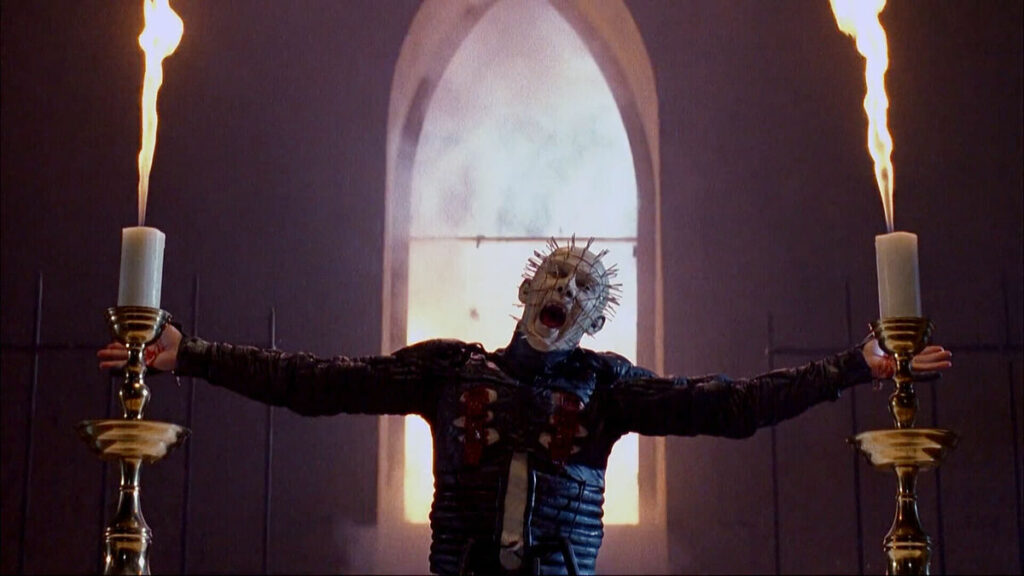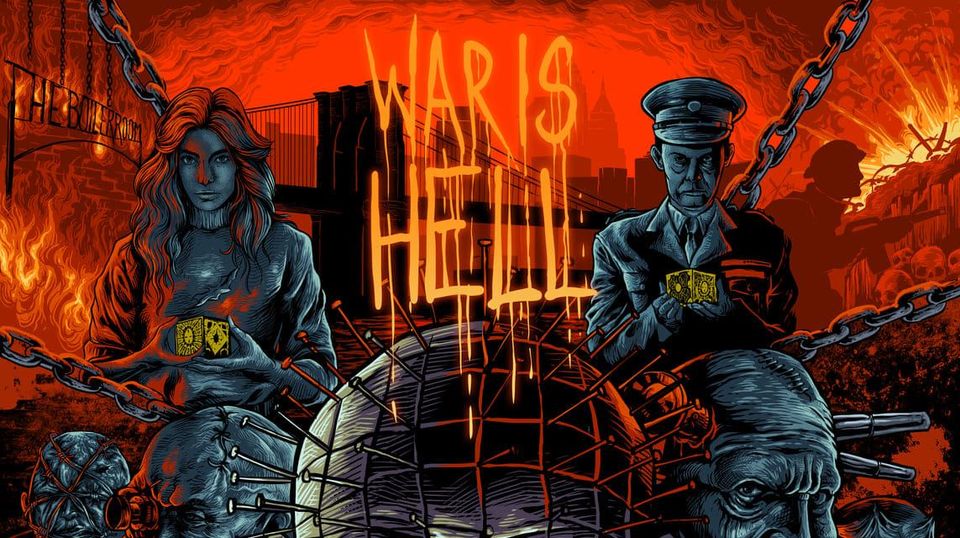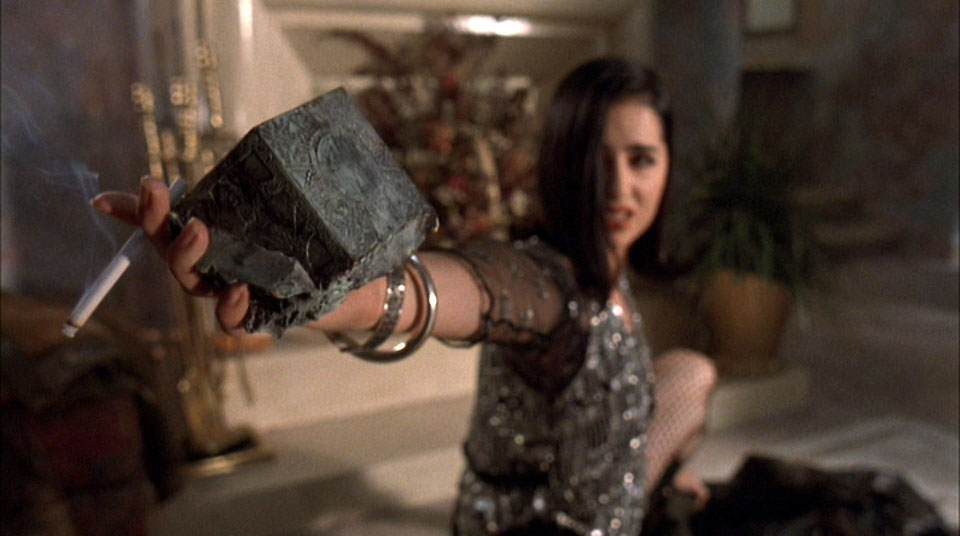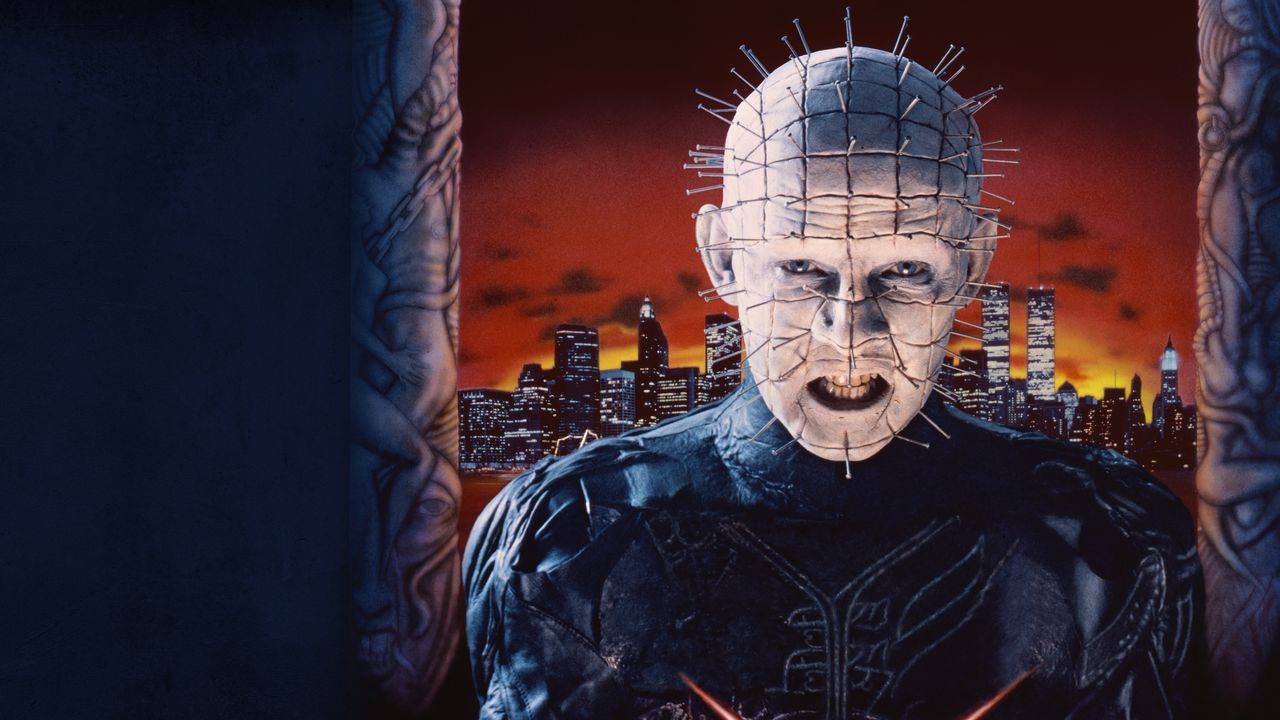Hellraiser III: Hell on Earth may be the third film in the series but in many ways it feels like the beginning of the franchise. The original Hellraiser was just that – original; Clive Barker’s twisted vision of a taboo relationship through the lens of low budget British horror. The sequel, Hellbound, concerned itself more with hell itself, being a fantastical dreamlike journey into its labyrinthine depths. The third film, however, now celebrating thirty years since release, set the roadmap for the what the franchise became. An American production, set on the streets of New York City, far from the quaint English house of the original, now with a slasher vibe and villain as the centrepiece: Pinhead.
Pinhead is Hellraiser’s most iconic image. He has been since his debut in the first film. Yet, on rewatch, you might be surprised how little a role the character has. He’s the head cenobite, a priest/prison guard from hell, yet this only justifies a mere cameo appearance. The sequel, too, he only appears briefly, with others taking on the antagonist roles. Hellbound was written and produced so soon after Hellraiser that the cultural impact couldn’t inform the work, but with years of delays before a third film, Hell on Earth became the first to capitalise on Pinhead’s popularity, and capitalise it did.
Personally, I do prefer the cenobites as an omnipotent force bound by rules, only a threat to those who seek them. Characters who can be scary and dangerous but still act as an ally if their desires align with the protagonist’s, like Kirsty in Hellraiser. Hell on Earth however makes Pinhead the baddie and, you know what, it’s great fun. It’s a devolution of sorts, a simplification; Pinhead becomes a straightforward slasher villain, a demon trying to take over Earth for his own hunger for power. What makes it work is Peter Atkin’s script, which keeps Pinhead as a well-spoken and almost poetic character, distancing him from silent or punny slashers from rival franchises, and also Doug Bradley’s performance.

Until recently, I had only seen the first two films in the series so was always surprised people loved Bradley as Pinhead so much. He’s fine, I guess, but it’s not until the third film where he can be unleashed and give a real meaty performance. Pinhead may have had an iconic look before but only here does the character join the pantheon of horror legends. Clive Barker’s only direction for Bradley during the first film was “do less.” Here, Bradley is doing more, much much more. It’s a proper arch horror villain performance where he spends half the film laughing maniacally. He sees himself a demonic messianic figure, defiling a church, melting a cross, and plucking some pins from his face to ‘stigmata’ himself. He also now has the ability to make things explode, which grows a little tiring after ten straight minutes of windows, fire hydrants, and manhole covers going boom.
Much of the film’s action surrounds nightclub The Boiler Room. Perhaps a more BDSM-y fetish-y vibe for the club would have fit better for the franchise but it works well enough. It also plays into just how wonderfully, disgustingly nineties the film feels. The costumes and music and tech scream the 1990s and I have a love/hate relationship with all of it. Even the cenobite designs, like CD, who throws CDs at people from a chest-mounted ejector tray, is simultaneously awful and brilliant. Thankfully, though, the film wisely keeps a grand orchestral score, with the less said about the awful song playing over the credits the better. The club, with all its grunge-y patrons, is the home to Pinhead’s great massacre, who is now free of hell’s rules and can and will kill anyone he likes. It’s a great sequence.
Joey, our protagonist, played by Terry Farrell, known as Jadzia Dax from the best Star Trek series, discovers the aftermath in the club in a sequence not typically seen in these films. Usually, slasher movies have a kill sequence and then promptly move on to setting up the next. Here, however, the film has its fun with the massacre but then fascinatingly has a character walk through the field of dead and take in the violence. The film manages to have its cake and eat it too; relishing the deaths but mourning the dead. The sequence is shot to draw parallel with an earlier scene in the film, in which we see the aftermath of the WWI battle at Flanders Fields. The ‘Hell on Earth’ of the title not only refers to Pinhead’s reign of terror but also the war that birthed him. Joey dreams of her father who died in the Vietnam war, and so imprints on Elliott Spencer, Pinhead’s revived human form, a WW1 officer, who reaches out to her from dream limbo. It’s weird and perhaps never quite all comes together but the film is trying to say something and is deeper than it has any right to be.

Hellraiser III is a surprisingly thematically rich film. Most aspects revolve around some facet of duology. The dichotomy of heaven and hell, good and evil. The Boiler Room nightclub is conjoined to a fancy restaurant, playing tranquil piano music to counter the grunge just a wall away. Joey is dressed in lighter colours while supporting character Terri, a co-lead for the first half, before she sides with Pinhead, wears darker clothes. And then there are two versions of Pinhead, the demon and the man he once was, battling each other. In the first film, Pinhead said he is seen as both angel and demon and now we see this literally as independent characters. He’s the devil on the shoulder of JP Monroe and the angel on the shoulder of Joey. Even the Lament Configuration, the dastardly box acting as a key to hell in previous films, now means salvation rather than damnation, able to cast out Pinhead rather than summon him, as a nice twist.
‘Twist on the franchise’ is really a nice way of saying retcon, which the series seems to have to do each time a sequel is required. Pinhead was turned human and died in the last film but here he’s resurrected, not once but twice as two separate entities. The big leviathan god of hell was defeated in Hellbound, and has to still be for Pinhead to rise, yet the hobo demon is still doing his job of spreading cenobite artifacts despite not having a master. But the big one, the retcon that really bothers me, is that Kirsty Cotton, the protagonist from the first two films, making a minor cameo, explains that the box, the key to hell, essentially opens itself. It moves your fingers in a trance because it wants to be opened. This ruins the whole point. Someone, whether Elliott Spencer or Frank, has to want to open the box, to seek its pleasures, and then get more than they bargained for. It’s one of the rules Pinhead is now so gleeful he’s shirked. Not to mention Hellbound had a puzzle-obsessed genius character just so there was someone to open the box.
The original Hellraiser was a relationship drama at its core. The story of a taboo extramarital affair with a sex-addict pleasure-seeker; it just so happens that he has escaped hell and has no skin. Hellraiser III does still tackle this subject matter, though less clearly or directly considering its more abundant horror tendencies. Terri is addicted to an abusive relationship and the feeding of blood to Pinhead in the bedroom is almost a metaphor for the fuelling of abuse between the lovers. I really like Terri and it’s a shame she’s written out of the film’s latter stages. JP Monroe is the other half of the abusive relationship, played by Kevin Bernhardt, looking like a young Benicio Del Toro in his Licence to Kill era. Monroe feels like an updated nineties version of Frank from the original, using his club, money, and power to manipulate women into sex before tossing them aside.

Hell on Earth is the first Hellraiser film to truly confirm its location. We get shots of Times Square and (almost) everyone has an American accent. The franchise has become truly Americanised, the more gothic and British sensibilities lost. The previous two films exist in some Mid-Atlantic netherworld. The first film was clearly shot in England with mainly English actors and then the American financiers tried all they could in post-production to change this, including dubbing actors with American accents. The second is similar, with the baffling appearance of an American cop wielding a gun on an English street. But now, three films in, the confusion is settled and Hellraiser has a home. It’s not like the next film is going to be split between space and 18th century France or anything.
Hellraiser III: Hell on Earth is somewhat unjustly maligned; a far more interesting film than some give it credit for, despite seemingly simplifying it down to a more generic horror film, complete with slasher villain. It’s actually the first time ‘Pinhead’ is ever called as such onscreen, a nickname creator Clive Barker hates. The performances are great, it’s reaching for some thematic examination, and it’s one hell of a nineties time capsule. Dare I say, I think it’s the second best movie in the franchise behind the original, with Hellbound and the 2022 reboot nipping at its heels. Although there are still some sequels I have dared not watch. You’d have to be a sadomasochist worthy of the Lament Configuration to suffer through those.








